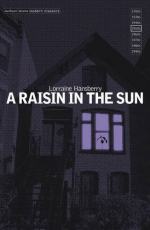|
|
A Raisin in the Sun Topic Tracking: Racism
Racism 1: One of the first major allusions to any sort of racism appears with the character of George Murchison. Prior to his entrance, the play simply discusses a poor family. However, when the wealthy Negro enters the picture, the Younger family sees the differences in race and group him with snobbish white people.
Racism 2: Bennie's African friend, Asagai, brings a new slant of the color line to the play. Because he is not the typical Negro of America at the time, but rather an African native studying in the States, another type of Negro is introduced. The color lines seem to blur yet again, for although Asagai is Negro, he is not the type of Negro that elicits much of the contemporary racism that the Youngers encounter. He is proud of his African roots and is proud of the color differences. His national distinctions perhaps bring into lighta new type of racism within the Black community.
Racism 3: Mama tells Walter Lee of the differences in racism from her generation to the present day. She was worried about her personal survival from lynching and hate crime. It seems as though her children have lost sight of the benefits of the new society. They simply see the problems they face as monumental, illustrating the relativity of the plight of society.
Racism 4: The family worries about Mama's decision to move the location of their new home. They will move to Clybourne Park, a white neighborhood. The family has hesitations about moving to an all white neighborhood, allowing the separation between the two races to persist.
Racism 5: Bennie teases Ruth and Walter about their old-fashioned dancing. However, she adds in the idea of "old-fashioned Negro" dancing. This word choice perpetuates the racial distinctions and separations. Within both races, people seem to label themselves by their color.
Racism 6: Karl Lindner overtly states the racism present in Clybourne Park. While he initially sugar coats his words, he eventually blurts out to the Youngers that they are not wanted in the white neighborhood because of the color of their skin.
Racism 7: Asagai voices a wise opinion of his African people. He wants to teach them and help them become educated men and women. He does not want the color line or racial distinctions to change their opportunities. However, Asagai never refers to his people as "Negroes" or "blacks." Instead, he always refers to them as Africans and villagers, erasing the color line and placing a national one in its place: a line of less hatred.
Racism 8: Walter Lee tells his family that he called Lindner back to beg for the money. He will play into the role of the inferior black man to a superior white man. He would have accepted the money offered to him and also accepted that low position. Mama scolds him and is shocked to learn that she has raised such a man with no pride.
Racism 9: When Lindner does in fact arrive at the Younger's home, Walter Lee has digested Mama's words. He tells Lindner that his family has pride and cannot be bought by money or color. It is through these words that Walter emerges a mature man.




